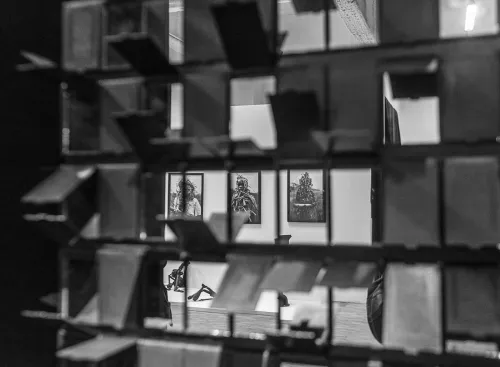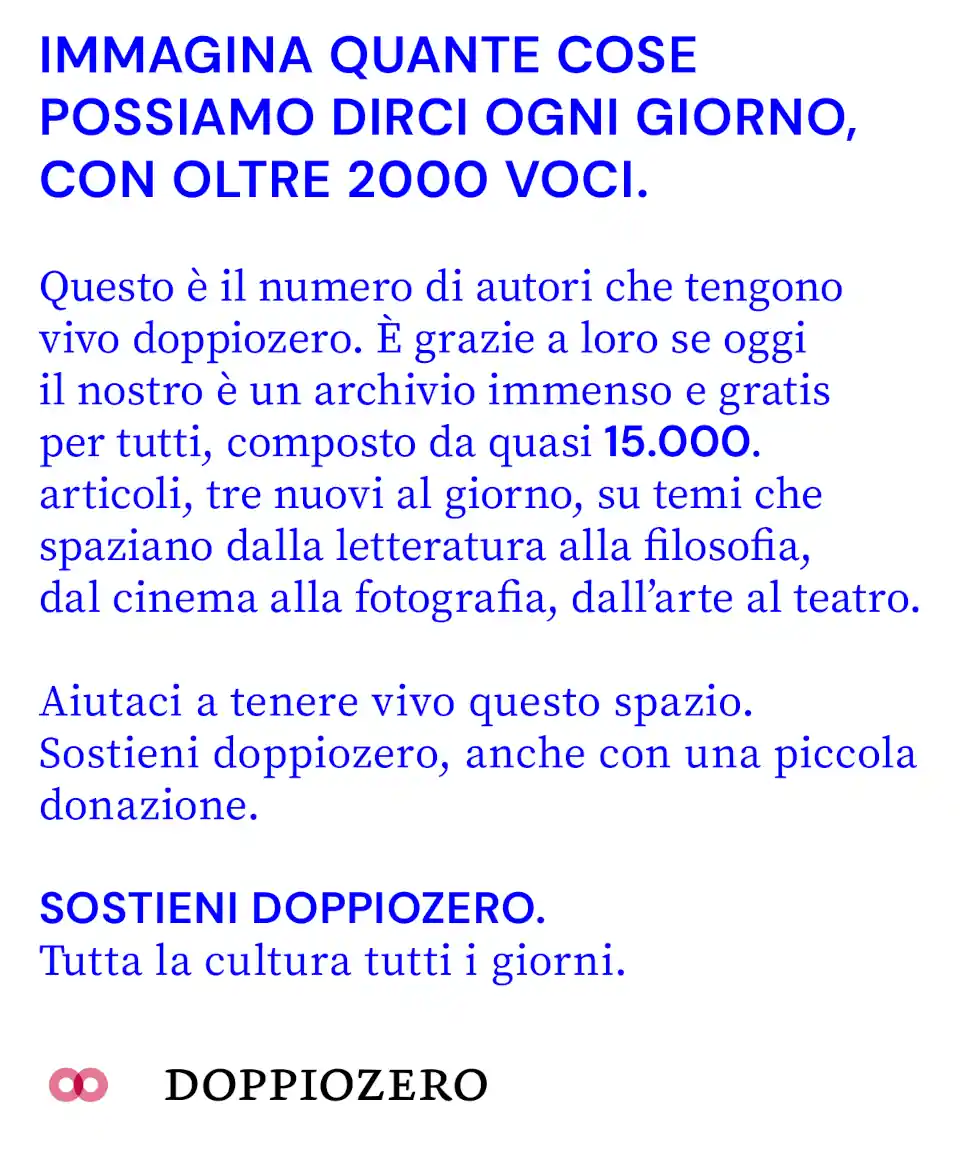Speciale
Notes on a Talk and an Exhibition / Art, Africa, Revolution
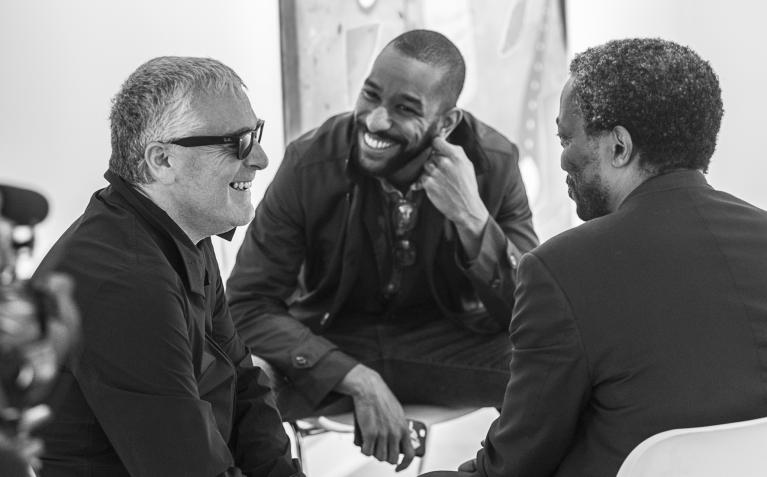
From left: Marco Scotini, artistic director of FM Centre for Contemporary Art, Milan; Adama Sanneh, Fondazione lettera27’s program director; Simon Njami, writer, curator, and artistic director of the Dakar Biennale in 2016 and 2018.
What is the purpose of art? This is a question I often ask myself, as a non-artist, a non-curator, and a woman who puts social engagement at the very top of her value list and is both attracted to and intimidated by visual arts. It is a question to which I finally managed to find a convincing answer (although partial and non-definitive), also thanks to Simon Njami, Adama Sanneh and Marco Scotini, who gave a talk on art, Africa and African representations at Frigoriferi Milanesi on April 1, 2017.
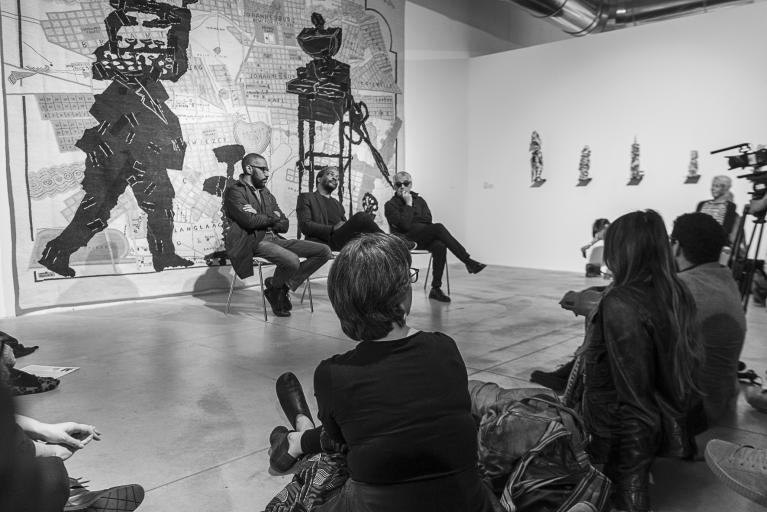
Talk with Simon Njami, Adama Sanneh and Marco Scotini held on the occasion of the exhibition The White Hunter. African memories and representations, FM Centre for Contemporary Art, Milan. In the background: William Kentridge, Office Love, 2001, Laura and Luigi Giordano Collection.
Behind the speakers was a tapestry by William Kentridge. From my position I could see an installation by Yinka Shonibare: headless mannequins, with wax-printed garments from the 18th-century, intent on looking at some library books. Like most of the audience, I was sitting cross-legged on the floor. This gave the artistic environment an elegant but informal feel.
The three-speaker talk was part of a series of events related to The White Hunter collective exhibition, which had been inaugurated the day before. The press described it as a contemporary African art exhibition, but it was not exactly so. It was actually a project aimed at establishing a dialogue between traditional and contemporary works of art from and on Africa; the focus was not on paintings and sculptures, but on the intertwining and asymmetrical looks that have been exchanged over time between white hunters and black preys.
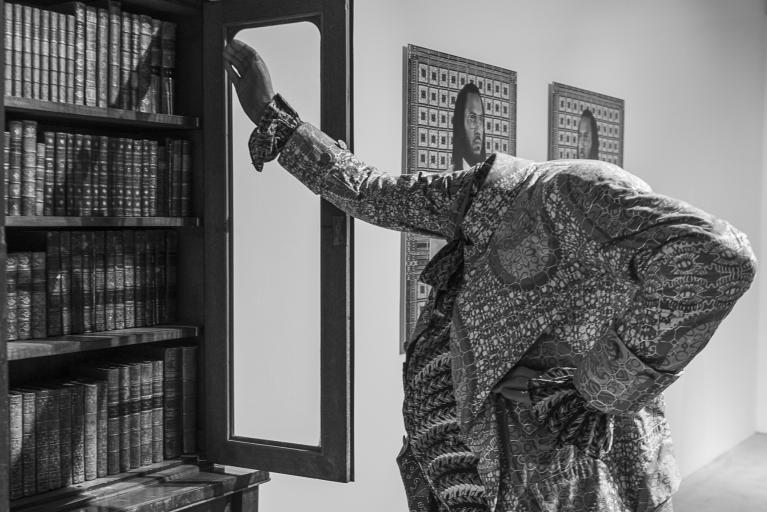
In the foreground: Yinka Shonibare, The Age of Enlightenment – Adam Smith, 2008, La Gaia Collection. In the background: Rashid Johnson, Self Portrait as the Professor of Astronomy, Miscegenation and Critical Theory at the New Negro Escapist Social and Athletic Club Centre for Graduate Studies, 2008.
Marco Scotini – a teacher at Naba, artistic director of the Frigoriferi Milanesi Centre for Contemporary Art, and curator of the exhibition – acted as host. Among his valuable advisors was Adama Sanneh, Fondazione lettera 27’s program director. Simon Njami, with his outstanding curatorial achievements and recent reappointment as artistic director of the Dakar Biennale, was the guest of honor. Introducing the event, Scotini immediately set things straight: the presence of the renowned curator of Cameroonian descent was neither an audience-attracting maneuver nor an accident. There were previous events that made his presence particularly significant in this context. The White Hunter exhibition was actually inspired by the first African sculpture exhibition created in Italy, at the Venice Biennale, in 1922. In line with the European cultural climate of the time, the 1922 exhibition followed an artistic rather than ethnographic approach, but was slated by the press and intellectual circles. The harsh criticism that it received led to the exclusion of African art from Italian cultural debates and art exhibitions for a long time.
Africa was officially welcomed back to Venice only in 2007, with a dedicated pavilion curated by Simon Njami and Fernando Alvim. The resulting exhibition, entitled Check-list, was not conceived as a showcase of African works of art but as an African space. The artists’ country of origin faded into the background compared to the content and range of meanings evoked. Works by Andy Wharol and Jean Michel Basquiat (USA), Alfredo Jaar (Chile), and Miguel Barcelò (Spain) were set alongside those by Bili Bidjocka (Cameroon), Ghada Amer (Egypt), and Santu Mofokeng (South Africa). The work by Njami and Alvim sparked both fierce criticism and enthusiastic applause.
Why is it important to remember the 2007 African pavilion? The event gave institutional recognition to a different way to look at Africa and its creative production, distancing itself from the views exemplified by Magiciens de la Terre, the global creativity exhibition curated by Jean-Hubert Martin at the Centre Pompidou in Paris in 1989. In other words, the African pavilion established the primacy of art over geography, of intention over spontaneity, of real people over the notion of African authenticity. “This rigid, artificial imagery is something truly damaging, ” says Njami. “At the time of Magiciens de la Terre, the curator in charge of the Africa section asked me for advice about Ivory Coast. I gave him the name of three artists. Later he complained, ‘You didn’t tell me they attended the Academy of Fine Arts,’ as if that were a hindrance. So what? ‘We were looking for authentic people.’ But who or what can be regarded as authentically African? Many exhibitions have been created with the aim of celebrating African authenticity. But when representation is transformed into an essence in itself, the (arbitrary) notion of authenticity becomes a criterion for exclusion, rather than a tool for knowledge. Those who do not meet these requirements are left out. Even though they are artists and live in Africa.”
Adama Sanneh was on the same wavelength. “We were glad to contribute to The White Hunter exhibition because it does not aim to represent, portray or explain Africa, but focuses on our gaze, which is a personal and subjective matter. It raises questions about the ‘other,’ but more importantly about ourselves. Why do we need to create diversity? To use James Baldwin’s words (a writer particularly in vogue these days, thanks to the film I Am Not Your Negro), why do you/we need a ‘nigger’ in the first place?And what is a nigger if not the hypostatization of diversity?”
In the first exhibition room, immediately after the African hut created by Pascal Marthine Tayou, it was possible to watch Pays Barbare, a film by Yervant Gianikian and Angela Ricci Lucchi. “The film includes archival footage from the 1920s,” explained Scotini. “Colonizers are shown in their light-colored uniforms and safari helmets, in contrast with the Africans’ naked bodies. There is a constant visual connection between the eye of the camera and the hunter’s scope. The explorer’s camera and the riflescope have the same target: after all, they’re big-game hunters. Our gaze is a determining and fundamental factor in the process of constructing otherness, which results in subalternity and subjugation. But it also reveals the viewer’s stance.”
There is no hunter without a prey. These roles are much more interchangeable than normally expected. “I know people who go to Africa to buy masks, feeling like hunters,” said Njami. “But end up getting swindled and turn into preys.”
The hunter/prey relationship, so evident in the colonial context, does not end with it. Mutatis mutandis, it can be found in all ages, in every relationship with otherness, in all forms of dominion. It is probably not eradicable. However, by becoming aware of it, we can come to a better understanding (of both ourselves and others) and take action. Not only, and not necessarily, to reverse roles and overturn power relations, but to avoid being caught both physically and in imagery terms. The uncatchable prey: that’s the way to revolution.
“By reasoning on these concepts, on the meaning of art, on how the image of Africa is constantly constructed and displayed, we can really question the society we live in.” With this remark, Adama Sanneh circles back to the original question. What is the purpose of art? What is the goal of exhibitions? We can try to answer: to raise questions, to sketch out answers, to remind us of the latent meaning hidden behind every manifest reality, to become – as Paul Ricoeur would have it – “masters of suspect.”
“Art does not necessarily take on this role, but it can actually serve this meaningful purpose and be a tool for the development of critical thinking. That is the way to change society. Artistic language makes it possible to address issues that would be off-limits in certain contexts, such as under authoritarian regimes. This is also confirmed by our experience with At Work, a project created by lettera27, in partnership with Simon Njami, to develop spaces for dialogue and inspire a new generation of thinkers, especially in places where this is not easily achievable.” This is also the aim of The White Hunter exhibition, which tries to deconstruct both our perspective and the recurring key words in all debates about Africa. At a time when the African continent has become “fashionable” in mainstream media, and the art market has begun to turn to African artists, the first thing to do is to put current trends aside and start questioning ourselves. For it is from doubt that revolution is born.
Traduzione di Laura Giacalone.
With the support of 
